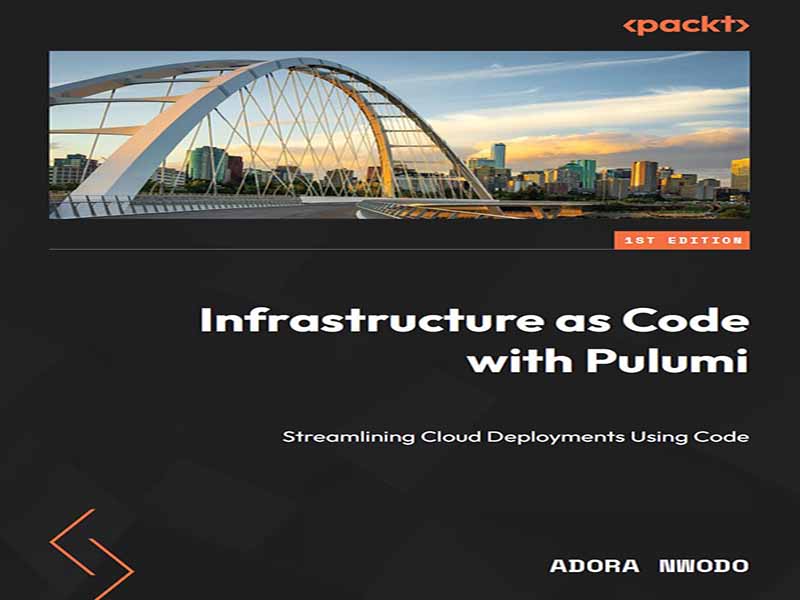- عنوان کتاب: Infrastructure as Code with Pulumi -Streamlining Cloud Deployments Using Code
- نویسنده: Adora Nwodo
- حوزه: DevOps
- سال انتشار: 2025
- تعداد صفحه: 384
- زبان اصلی: انگلیسی
- نوع فایل: pdf
- حجم فایل: 9.61 مگابایت
در گذشته، راهاندازی زیرساخت ابری اغلب به معنای کلیک کردن در داشبوردهای بیپایان، اجرای اسکریپتهای دستی و امید به اینکه همه چیز دفعه بعد که به آن نیاز داشتید به همان شکل پیکربندی شده باشد، بود. با گذشت زمان، این رویکرد دیگر با سرعت و پیچیدگی سیستمهای مدرن همگام نبود. تیمها به چیزی قابل اعتمادتر، تکرارپذیرتر و مقیاسپذیرتر نیاز داشتند. اینجاست که زیرساخت به عنوان کد (IaC) وارد عمل میشود. با تعریف زیرساخت در کد، تیمها میتوانند محیطهایی را که برنامههایشان به آنها وابسته هستند، نسخهبندی، بررسی و خودکارسازی کنند. پولومی این ایده را با اجازه دادن به شما برای نوشتن زیرساخت در همان زبانهای برنامهنویسی که قبلاً برای توسعه برنامه استفاده میکنید، پیش میبرد و هر دو جهان را به روشی طبیعی و انعطافپذیر گرد هم میآورد. این کتاب اینجاست تا به شما در ایجاد این تغییر کمک کند. ما با اصول اولیه IaC و ایدههای اصلی پولومی شروع خواهیم کرد، سپس به استقرارهای عملی در سراسر AWS، Azure، Google Cloud و Kubernetes خواهیم پرداخت. شما یاد خواهید گرفت که چگونه پولومی را در خطوط لوله CI/CD ادغام کنید، در چندین منطقه و ارائه دهنده کار کنید و از اکوسیستم غنی ارائه دهنده که پولومی را بسیار فراتر از ابرهای اصلی گسترش میدهد، بهره ببرید. بعداً، ویژگیهای پیشرفته، شیوههای اثباتشده برای نوشتن کد زیرساخت تمیز و قابل نگهداری، و روشهای اعمال مدیریت با Policy as Code را بررسی خواهیم کرد. همچنین یاد خواهید گرفت که چگونه از ابزارهای دیگر مهاجرت کنید و مهارتهای خود را با تمرینهای سبک دنیای واقعی آزمایش کنید. هر فصل توضیحات واضح را با مثالهای عملی ترکیب میکند تا بتوانید آنچه را که یاد میگیرید فوراً به کار ببرید. هدف این است که به شما دانش و اعتماد به نفس لازم برای خودکارسازی زیرساخت برای هر چیزی، از یک اثبات مفهوم کوچک گرفته تا یک سیستم تولید چند ابری پیچیده، را بدهد. این کتاب برای چه کسانی مناسب است؟ این کتاب برای مهندسان DevOps، مهندسان ابری، مهندسان قابلیت اطمینان سایت، مهندسان زیرساخت و مهندسان پلتفرم است که میخواهند روشهای جدید مدیریت زیرساخت را با استفاده از Pulumi به عنوان یک جایگزین مدرن برای زیرساختهای سنتی به عنوان ابزار کد بررسی کنند. همچنین برای مهندسان نرمافزار در هر سطح تجربهای که میخواهند مهارتهای خود را در مهندسی زیرساخت گسترش دهند، مناسب است. آشنایی اولیه با مفاهیم ابری و حداقل یک زبان برنامهنویسی به شما کمک میکند تا بیشترین بهره را از این کتاب ببرید. آنچه این کتاب پوشش میدهد: فصل ۱، مقدمهای بر زیرساخت به عنوان کد و پولومی، درکی از زیرساخت به عنوان کد (IaC) و چگونگی امکان مدیریت منابع ابری توسط پولومی از طریق کد، مفاهیم اصلی، اصول و گردشهای کاری ضروری CLI را ارائه میدهد. فصل ۲، ایجاد اولین IaC پولومی، خوانندگان را در فرآیند عملی ساخت اولین پروژه زیرساخت به عنوان کد خود با استفاده از پولومی راهنمایی میکند. فصل ۳، استقرار با پولومی در AWS، خوانندگان را در استفاده از پولومی برای استقرار و مدیریت زیرساخت در سرویسهای وب آمازون راهنمایی میکند. فصل ۴، استقرار با پولومی در Azure، خوانندگان را با استقرار و مدیریت زیرساخت در Microsoft Azure با استفاده از پولومی آشنا میکند. فصل ۵، استقرار با پولومی در Google Cloud، خوانندگان را با استقرار و مدیریت زیرساخت در Google Cloud با استفاده از پولومی آشنا میکند. فصل 6، استقرار با Pulumi در Kubernetes، مدیریت خوشهها و بارهای کاری Kubernetes با Pulumi، از جمله راهاندازی محیط، استقرار منابع، بهترین شیوههای پیکربندی، مقیاسبندی و دسترسیپذیری بالا را پوشش میدهد. فصل 7، ادغام Pulumi با خطوط لوله CI/CD، نحوه ادغام Pulumi با خطوط لوله CI/CD را برای خودکارسازی استقرار زیرساخت، پوشش راهاندازی گردش کار، مدیریت اسرار، استراتژیهای بازگشت به عقب و بهترین شیوههای امنیتی خط لوله توضیح میدهد. فصل 8، بررسی اکوسیستم ارائهدهنده Pulumi، پشتیبانی Pulumi از چندین ارائهدهنده ابر و خدمات را بررسی میکند، جزئیات راهاندازی ارائهدهنده، مدیریت منابع و ادغام متقابل ارائهدهنده برای کنترل یکپارچه زیرساخت را شرح میدهد. فصل 9، مدیریت IaC شما در مناطق و محیطهای متعدد، بهترین شیوهها را برای مدیریت زیرساخت چند منطقهای و چند محیطی با Pulumi، از جمله پیکربندیهای خاص محیط، جداسازی منابع و مرحلهبندی گردشهای کار، پوشش میدهد. فصل 10، مدیریت سناریوهای چندابری و ترکیبی، به بررسی هماهنگی زیرساختهای چندابری و ترکیبی با Pulumi میپردازد و مزایا، چالشها و بهترین شیوههای شبکهسازی، یکپارچهسازی دادهها و امنیت در پلتفرمهای مختلف را پوشش میدهد. فصل 11، ویژگیهای پیشرفته Pulumi، به بررسی قابلیتهای پیشرفته Pulumi، از جمله Pulumi ESC (محیطها، اسرار و پیکربندی)، Pulumi AI و API اتوماسیون میپردازد. فصل 12، نوشتن کد قابل نگهداری، قابل آزمایش و مقیاسپذیر در Pulumi، الگوهای برنامهنویسی و اصول طراحی را در Pulumi IaC اعمال میکند و بر ماژولاریتی، قابلیت استفاده مجدد و بهترین شیوهها برای ساختار پروژه، نامگذاری و مستندسازی تأکید دارد. فصل 13، آزمایش و اشکالزدایی Pulumi IaC شما، در مورد اهمیت آزمایش زیرساخت Pulumi شما به عنوان کد (IaC) صحبت میکند تا اطمینان حاصل شود که منابع ابری شما به درستی، ایمن و کارآمد پیکربندی شدهاند. فصل 14، پیادهسازی سیاست به عنوان کد، بر … تمرکز دارد.
In the past, setting up cloud infrastructure often meant clicking through endless dashboards, running manual scripts, and hoping everything was configured the same way the next time you needed it. Over time, that approach stopped keeping up with the speed and complexity of modern systems. Teams needed something more reliable, more repeatable, and easier to scale. That is where Infrastructure as Code (IaC) comes in. By defining infrastructure in code, teams can version, review, and automate the environments their applications depend on. Pulumi takes this idea further by letting you write infrastructure in the same programming languages you already use for application development, bringing both worlds together in a way that feels natural and flexible. This book is here to help you make that shift. We will start with the basics of IaC and Pulumi’s core ideas, then move into hands-on deployments across AWS, Azure, Google Cloud, and Kubernetes. You will learn how to integrate Pulumi into CI/CD pipelines, work across multiple regions and providers, and take advantage of the rich provider ecosystem that extends Pulumi far beyond the major clouds. Later, we will explore advanced features, proven practices for writing clean and maintainable infrastructure code, and ways to enforce governance with Policy as Code. You will also learn how to migrate from other tools and put your skills to the test with real world style exercises. Each chapter mixes clear explanations with practical examples so you can apply what you learn immediately. The aim is to give you both the knowledge and the confidence to automate infrastructure for anything from a small proof of concept to a complex multi cloud production system. Who this book is for This book is for DevOps engineers, cloud engineers, site reliability engineers, infrastructure engineers, and platform engineers who want to explore new ways of managing infrastructure using Pulumi as a modern alternative to traditional infrastructure as code tools. It is also for software engineers at any experience level who want to expand their skills into infrastructure engineering. Basic familiarity with cloud concepts and at least one programming language will help you get the most out of this book. What this book covers: Chapter 1, Introduction to Infrastructure as Code and Pulumi, provides an understanding of Infrastructure as Code (IaC) and how Pulumi enables managing cloud resources through code, covering core concepts, principles, and essential CLI workflows. Chapter 2, Creating Your First Pulumi IaC, guides readers through the hands-on process of building their first infrastructure as code project using Pulumi. Chapter 3, Deploying with Pulumi on AWS, guides readers through using Pulumi to deploy and manage infrastructure on Amazon Web Services. Chapter 4, Deploying with Pulumi on Azure, introduces readers to deploying and managing infrastructure on Microsoft Azure using Pulumi. Chapter 5, Deploying with Pulumi on Google Cloud, introduces readers to deploying and managing infrastructure on Google Cloud using Pulumi. Chapter 6, Deploying with Pulumi on Kubernetes, covers managing Kubernetes clusters and workloads with Pulumi, including environment setup, resource deployment, configuration best practices, scaling, and high availability. Chapter 7, Integrating Pulumi with CI/CD Pipelines, explains how to integrate Pulumi with CI/CD pipelines to automate infrastructure deployment, covering workflow setup, secrets management, rollback strategies, and pipeline security best practices. Chapter 8, Exploring Pulumi’s Provider Ecosystem, explores Pulumi’s support for multiple cloud and service providers, detailing provider setup, resource management, and cross-provider integration for unified infrastructure control. Chapter 9, Managing your IaC in Multiple Regions and Environments, covers best practices for multi-region and multi-environment infrastructure management with Pulumi, including environment- specific configurations, resource isolation, and staging workflows. Chapter 10, Managing Multi-Cloud and Hybrid Scenarios, explores multi-cloud and hybrid infrastructure orchestration with Pulumi, covering benefits, challenges, and best practices for networking, data integration, and security across platforms. Chapter 11, Advanced Pulumi Features, explores the advanced capabilities of Pulumi, including the Pulumi ESC (Environments, Secrets, and Configuration), Pulumi AI and Automation API. Chapter 12, Writing Maintainable, Testable, and Scalable Code in Pulumi, applies programming paradigms and design principles to Pulumi IaC, emphasizing modularity, reusability, and best practices for project structure, naming, and documentation. Chapter 13, Testing and Debugging Your Pulumi IaC, talks about the importance of testing your Pulumi Infrastructure as Code (IaC) to ensure that your cloud resources are configured correctly, securely, and efficiently. Chapter 14, Implementing Policy as Code, focuses on using Pulumi’s policy framework to enforce compliance, security, and operational best practices within infrastructure as code. Chapter 15, Migrating From Other Tools to Pulumi, guides migrating existing IaC projects to Pulumi, covering framework evaluation, configuration translation, multi-language support, state management, and best practices for a smooth, low-downtime transition. Chapter 16, Tests and Exercises on Infrastructure Automation with Pulumi, provides practical exercises and case studies to reinforce the concepts learned throughout the book.
این کتاب را میتوانید از لینک زیر بصورت رایگان دانلود کنید:
Download: Infrastructure as Code with Pulumi



































نظرات کاربران